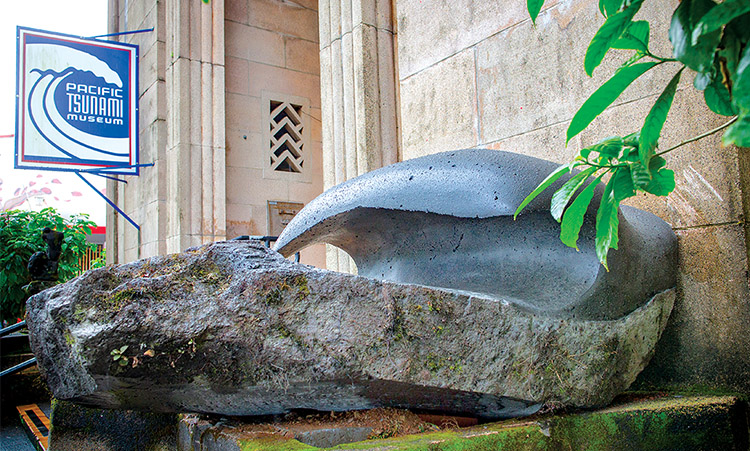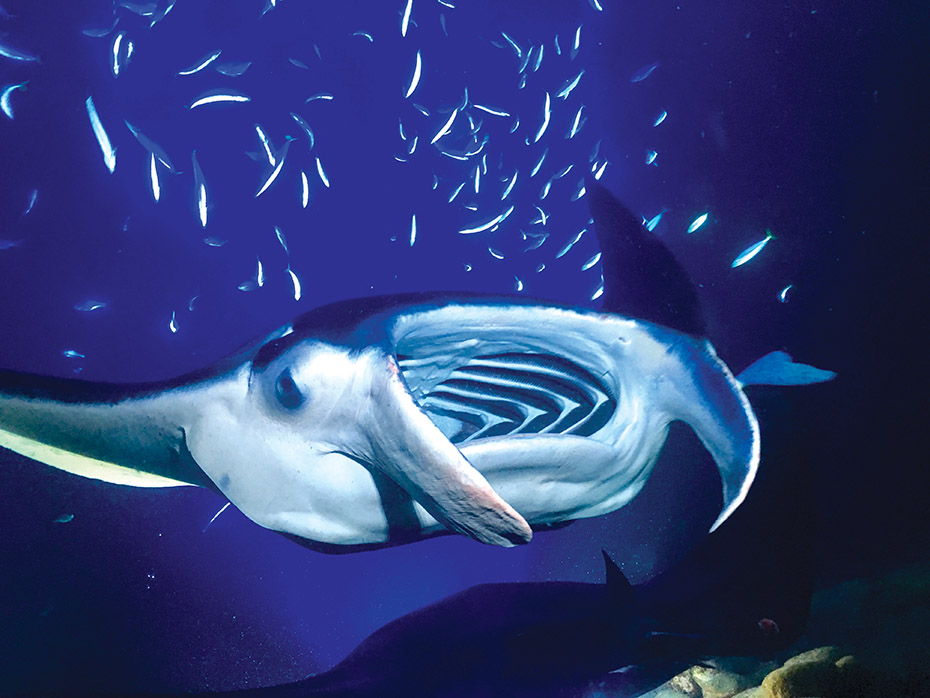
Manta Pacific Research Foundation: Conserving and Protecting the Ballerinas of the Ocean
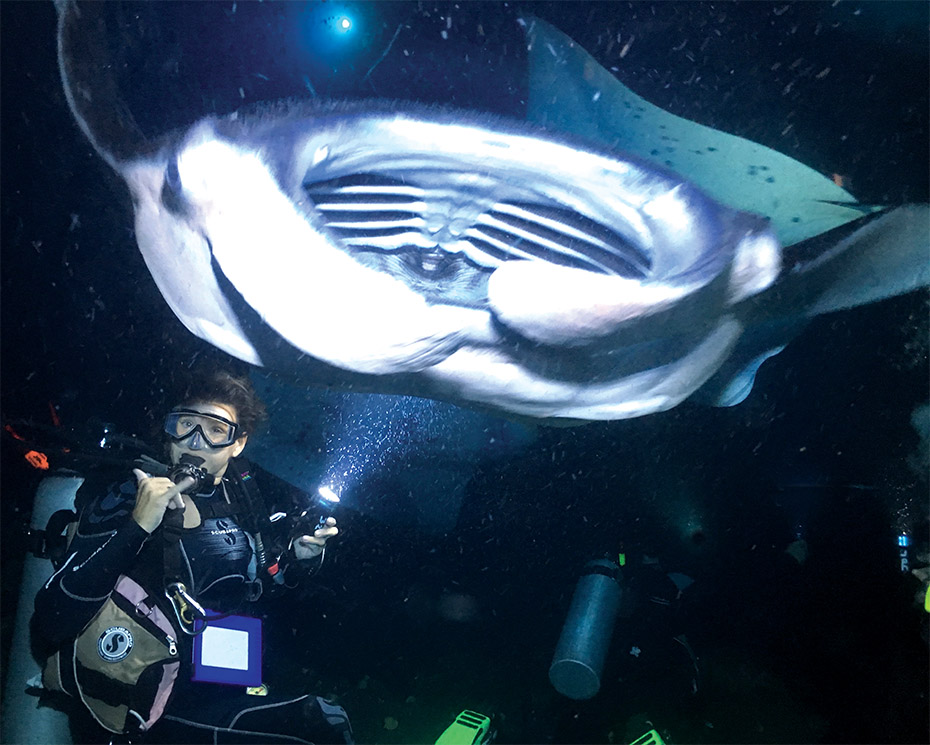
By Karen Rose
”The world’s finest wilderness lies beneath the waves,” says marine life artist Wyland. Keller Laros, president of the Manta Pacific Research Foundation (MPRF), agrees. Keller and his wife Wendy founded MPRF in 2002 out of their passion for manta rays. The mission of this 501(c)(3) nonprofit organization is to study manta rays in their natural habitat, conduct scientific research, provide education programs for the public about manta rays and the marine environment, and to establish and promote global manta ray conservation.
An underwater photographer, videographer, and certified SCUBA instructor, Keller had his first encounter with the Kona manta rays in 1985. “The summer after I graduated from college as a political science major I visited Kona with my family,” said Keller. “We went on a manta ray night dive with Jack’s Diving Locker. After my experience with the night dive, I fell in love with manta rays. They’re that kind of animal. They really affected me, so I gave up the idea of being a lawyer to become a SCUBA instructor and move to Hawai‘i.” He moved to Kona in 1991 and started leading manta ray dives shortly after.
How the Foundation Began
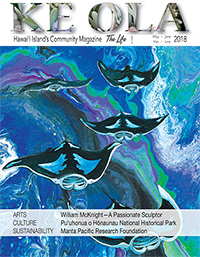
“The manta dive started to become really popular and people kept asking all kinds of questions, like, ‘How long do manta rays live?’ and ‘How do you tell a male from a female?’,” Keller recounts. “Wendy and I sort of cobbled together whatever information we could find and created the PADI (Professional Association of Diving Instructors) Manta Ray Scuba Diver course, which I taught at Jack’s Diving Locker.”
It was during this time when Keller met an interested philanthropist on one of the dives he was leading. “It was late 2000 when one our passengers asked me how much money we needed for our research,” said Keller. “I asked him what he meant and he answered, ‘$10,000 or $100,000?’. I’d never had anyone ask me anything like that before.”
At the time, the foundation was just an idea and not yet a nonprofit organization. Since the donor needed to make a donation before the end of the year, Keller suggested he support his friend, and later Manta Pacific scientific advisor, Tim Clark, who was set to begin his PhD at University of Hawai‘i at Mānoa.
Keller says, “Tim got his PhD funded, and it also gave me the impetus to complete the paperwork and requirements needed to become a nonprofit organization.” The support paid off, and today the Manta Pacific Research Foundation is led by a talented team of volunteers and supported by a community of people who are fueled by a passion for these magnificent creatures.
Manta rays are one of the largest animals in the ocean. Hailing from tropical, subtropical, and temperate waters, their wingspans often reach over 20 feet across. In the Hawaiian language, they are called hāhālua. The manta ray’s wide triangular wings are used to propel themselves gracefully through the water, taking on the characteristics of underwater angels.
“Each manta ray has a unique set of spots on their abdomen,” said Keller. “The first manta we got to know was Lefty. We noticed her left cephalic fin was folded up in front of her face and were able to identify her as an individual. I got the photo of Lefty and upon comparing it with other manta rays, I realized each manta had their own set of spots.”

This began the manta identification project, which still is in existence today. The oldest photo of Lefty dates back to 1979, however Keller sadly notes they haven’t seen her since 2016.
Beginning in 1991, photographs were used to create an identification catalog. MPRF has identified and cataloged 266 manta rays in the waters around Hawai‘i Island with the assistance of volunteer citizen scientists.
“It’s a very interesting population,” Keller continues, “there are two species of manta, the birostris: the pelagic (off shore) manta and the far more numerous alfredi (near shore) manta. There are another 117 mantas in Maui; however none of the alfredi have ever been sighted on both islands, giving us our own little kama‘āina (resident) population of manta alfredi rays here.”
By 1993 the dive had become very popular, going from one or two boats per night to as many as six per night. Wanting to be proactive, several local commercial operators and manta enthusiasts got together with PADI Project Aware as a sponsor, to write guidelines for how to conduct a proper manta ray night dive.
“Most scuba divers are happy to passively watch the mantas, but occasionally someone would reach out and grab onto a passing ray. This frightens the mantas away and ruins the experience for everyone,” explained Keller. “The guidelines were printed and distributed by PADI’s Project AWARE (Aquatic World Awareness Responsibility and Education). The guidelines have worked so well within the local community, the dive has thrived as a result.”
In addition to researching manta rays, the Manta Pacific Research Foundation also promotes global manta ray conservation. From 2003 to 2009, Keller, alongside the foundation and several commercial operators, combined forces to help pass legislation protecting the marine animals. Today, manta rays are protected in the state of Hawai‘i due to the efforts of MPRF and other dedicated individuals.
“In 2009, we finally got the law passed making it illegal to kill or capture manta rays in Hawai‘i,” said Keller. “It took six years to get that done, but it was well worth it.”
In 2013, Keller was on a manta ray night dive when a bottlenose dolphin paid a visit to the divers. Noticing the dolphin’s left pectoral fin was wrapped in fishing line, he signaled the dolphin to approach him. The dolphin swam over to Keller and he carefully removed the line and hook from the animal’s fin. The rescue was captured on video and received tens of millions of views. Scuba divers have removed fishing line from mantas and sea turtles several times over the years. Keller describes one of these encounters.
“We received word that one of our manta rays, Koie, had gotten fishing line tangled around her right pectoral fin,” he said. “It trailed off behind her and it was slowly cutting into her wing. I got a pair of wire cutters, and during the night dive, she came up and slowly circled as three of us took turns cutting the fishing line off of her. You could tell it hurt, but she knew we were there to help so she kept turning around and coming back. Over the course of about 15 minutes, we were able to remove all the fishing line. It worked out really well. Sheʻs still got a scar on the front of her pectoral fin, but the rear of it is completely healed. That was pretty cool.”
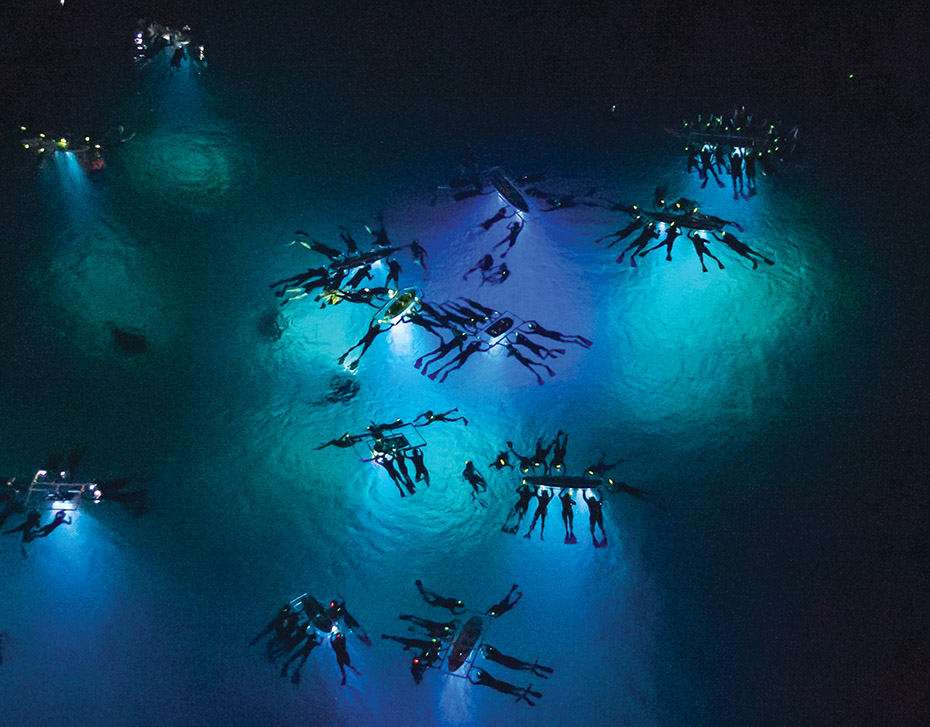
Another project of the MPRF was the creation of the Manta Learning Center, located at the Sheraton Kona Resort and Spa at Keauhou Bay. Keller and Wendy collaborated with the Sheraton and underwater photographer Bo Pardue to establish a place where visitors can learn more about these amazing animals.
“Wendy provided information and educational design, Bo got the pictures, and I produced the manta ray identification video that plays on the monitor,” said Keller. “We built the Manta Learning Center so when people are interested in manta rays, they can go down there and check it out.”
The Manta Learning Center is located in the hotel hallway leading into the restaurant, Rays on the Bay. The restaurant, and areas around it, provide an outstanding view of the ocean. At night, bright lights from the resort shine into the water attracting plankton, which attracts manta rays.
A current concern of the foundation and the manta community is the increased number of people—commercial operators as well as non-commercial snorkelers and scuba divers—conducting manta snorkels and dives. The popularity of swimming with mantas has grown exponentially. It has gotten to the point where there are too many boats and untrained people in the water at the manta sites. The Manta Pacific Research Foundation as well as several commercial operators have been working with the state to come up with a management plan to protect the environment from anchor damage as well as protect the mantas from potentially being harmed.
As far as future projects go, Keller has ambitious plans for the foundation. “One of our future projects is to collect DNA samples of the manta rays here in Kona so we can compare them to one another and create a family tree,” he said. “Manta rays live a long time and it would be interesting to discover who is related to who.”
The future of Kona’s manta rays is in good hands with the Manta Pacific Research Foundation.
“Iʻm just so crazy about manta rays,” said Keller. “I look at the manta rays and can recognize maybe 100 or more of them. They’re unique creatures. Theyʻre intelligent. Theyʻre beautiful. Theyʻre graceful. Theyʻre mysterious. We need to protect the manta rays and perpetuate the biodiversity.” ❖
For more information: mantapacific.org
Mahalo Jack’s Diving Locker – Ocean Story Sponsor

